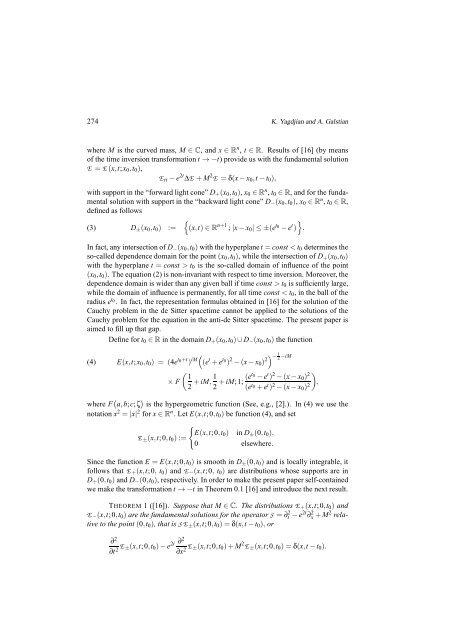The Klein-Gordon equation in anti-de Sitter spacetime - Seminario ...
The Klein-Gordon equation in anti-de Sitter spacetime - Seminario ...
The Klein-Gordon equation in anti-de Sitter spacetime - Seminario ...
Create successful ePaper yourself
Turn your PDF publications into a flip-book with our unique Google optimized e-Paper software.
274 K. Yagdjian and A. Galstianwhere M is the curved mass, M ∈ C, and x ∈ R n , t ∈ R. Results of [16] (by meansof the time <strong>in</strong>version transformation t →−t) provi<strong>de</strong> us with the fundamental solutionE =E(x,t;x 0 ,t 0 ),E tt − e 2t ∆E + M 2 E = δ(x−x 0 ,t− t 0 ),with support <strong>in</strong> the “forward light cone” D + (x 0 ,t 0 ), x 0 ∈R n , t 0 ∈R, and for the fundamentalsolution with support <strong>in</strong> the “backward light cone” D − (x 0 ,t 0 ), x 0 ∈R n , t 0 ∈R,<strong>de</strong>f<strong>in</strong>ed as follows{}(3) D ± (x 0 ,t 0 ) := (x,t)∈R n+1 ;|x−x 0 |≤±(e t 0− e t ) .In fact, any <strong>in</strong>tersection of D − (x 0 ,t 0 ) with the hyperplane t = const < t 0 <strong>de</strong>term<strong>in</strong>es theso-called <strong>de</strong>pen<strong>de</strong>nce doma<strong>in</strong> for the po<strong>in</strong>t(x 0 ,t 0 ), while the <strong>in</strong>tersection of D + (x 0 ,t 0 )with the hyperplane t = const > t 0 is the so-called doma<strong>in</strong> of <strong>in</strong>fluence of the po<strong>in</strong>t(x 0 ,t 0 ). <strong>The</strong> <strong>equation</strong> (2) is non-<strong>in</strong>variant with respect to time <strong>in</strong>version. Moreover, the<strong>de</strong>pen<strong>de</strong>nce doma<strong>in</strong> is wi<strong>de</strong>r than any given ball if time const > t 0 is sufficiently large,while the doma<strong>in</strong> of <strong>in</strong>fluence is permanently, for all time const < t 0 , <strong>in</strong> the ball of theradius e t 0. In fact, the representation formulas obta<strong>in</strong>ed <strong>in</strong> [16] for the solution of theCauchy problem <strong>in</strong> the <strong>de</strong> <strong>Sitter</strong> <strong>spacetime</strong> cannot be applied to the solutions of theCauchy problem for the <strong>equation</strong> <strong>in</strong> the <strong>anti</strong>-<strong>de</strong> <strong>Sitter</strong> <strong>spacetime</strong>. <strong>The</strong> present paper isaimed to fill up that gap.Def<strong>in</strong>e for t 0 ∈R <strong>in</strong> the doma<strong>in</strong> D + (x 0 ,t 0 )∪D − (x 0 ,t 0 ) the function(4)E(x,t;x 0 ,t 0 ) = (4e t 0+t ) iM( (e t + e t 0) 2 −(x−x 0 ) 2) − 1 2 −iM× F( 12 + iM, 1 2 + 0− e t ) 2 −(x−x 0 ) 2 )iM;1;(et (e t 0 + e t ) 2 −(x−x 0 ) 2 ,where F ( a,b;c;ζ ) is the hypergeometric function (See, e.g., [2].). In (4) we use thenotation x 2 =|x| 2 for x∈R n . Let E(x,t;0,t 0 ) be function (4), and setE ± (x,t;0,t 0 ) :={E(x,t;0,t 0 ) <strong>in</strong> D ± (0,t 0 ),0 elsewhere.S<strong>in</strong>ce the function E = E(x,t;0,t 0 ) is smooth <strong>in</strong> D ± (0,t 0 ) and is locally <strong>in</strong>tegrable, itfollows thatE + (x,t;0, t 0 ) andE − (x,t;0, t 0 ) are distributions whose supports are <strong>in</strong>D + (0,t 0 ) and D − (0,t 0 ), respectively. In or<strong>de</strong>r to make the present paper self-conta<strong>in</strong>edwe make the transformation t →−t <strong>in</strong> <strong>The</strong>orem 0.1 [16] and <strong>in</strong>troduce the next result.THEOREM 1 ([16]). Suppose that M ∈C. <strong>The</strong> distributionsE + (x,t;0,t 0 ) andE − (x,t;0,t 0 ) are the fundamental solutions for the operatorS = ∂ 2 t − e2t ∂ 2 x + M2 relativeto the po<strong>in</strong>t(0,t 0 ), that isSE ± (x,t;0,t 0 )=δ(x,t− t 0 ), or∂ 2∂t 2E ±(x,t;0,t 0 )−e 2t ∂ 2∂x 2E ±(x,t;0,t 0 )+M 2 E ± (x,t;0,t 0 )=δ(x,t− t 0 ).














